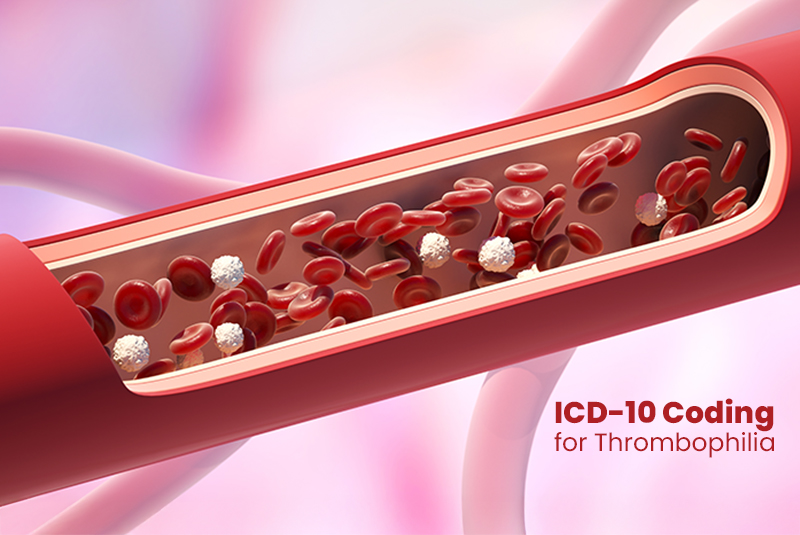Thrombophilia is a medical condition that increases the risk of developing abnormal blood clots in the veins or arteries. Accurate ICD-10 coding for thrombophilia is crucial for proper documentation, appropriate billing, and optimal patient care. Following the right vascular medical coding practices and adhering to medical coding guidelines ensures clarity in medical records and reduces the likelihood of claim denials. In this post, we will explore the ICD-10 codes for thrombophilia, outline best practices for coding thrombophilia in medical records, and highlight the common pitfalls to avoid.
Avoid Costly Medical Coding Errors
Contact our expert medical coding company.
Call: (800) 670-2809
Understanding Thrombophilia and Its ICD-10 Codes
Thrombophilia can be an inherited (genetic) or acquired tendency to form blood clots in the arteries and veins. This type of distinction is essential when assigning ICD-10 codes. The primary ICD-10 code for thrombophilia is – “D68.5 Primary thrombophilia”
However, depending on the patient’s condition, other related codes may include:
- D68.51 Activated protein C resistance
- D68.52 Prothrombin gene mutation
- D68.59 Other primary thrombophilia
- D68.6 Other thrombophilia
- D68.61 Antiphospholipid syndrome
- D68.62 Lupus anticoagulant syndrome
- D68.69 Other thrombophilia
- D68.8 Other specified coagulation defects
- D68.9 Coagulation defect, unspecified
Properly identifying and coding the type of thrombophilia – whether inherited thrombophilia or secondary to another condition – is a vital component of vascular medical coding.
Best Practices for Coding Thrombophilia
- Differentiate Inherited vs Acquired Thrombophilia – Always determine whether the condition is genetic (e.g. Factor V Leiden, protein C or S deficiency) or acquired (e.g. due to malignancy or antiphospholipid syndrome). For inherited thrombophilia, codes D68.52 or D68.59 may be appropriate.
- Use Supporting Documentation – Accurate coding depends heavily on provider documentation. Include lab findings, family history, and genetic test results when available. Ensure that the terms “inherited thrombophilia,” “hypercoagulable state,” or “prothrombotic disorder” are explicitly mentioned in the record.
- Adhere to Medical Coding Guidelines – Consult the official ICD-10-CM guidelines and facility-specific protocols. Coders should not infer diagnoses without physician confirmation.
- Code Secondary Conditions Appropriately – Thrombophilia can be linked to deep vein thrombosis (DVT), pulmonary embolism, or stroke. Always assign additional codes for these complications if documented. Accurate linkage improves clinical accuracy and reimbursement.
- Query When in Doubt – If documentation is unclear, especially regarding the type or cause of thrombophilia, a physician query is recommended. This ensures compliance with medical coding standards and improves claim outcomes.
Let us help streamline your thrombophilia billing and coding.
Common Pitfalls in Thrombophilia ICD-10 Coding
- Using unspecified codes when specific ones apply – Many coders default to D68.59 without investigating further. If a more specific code exists, such as D68.51 or D68.52, it should be used to enhance coding specificity.
- Failing to link thrombophilia to complications – Not connecting thrombophilia to events like DVT can result in incomplete claims and affect treatment history accuracy.
- Overlooking inherited thrombophilia diagnosis – If lab tests or genetic reports are available, they should guide the use of terms like “inherited thrombophilia” in documentation. Coders should not assume a diagnosis based on family history alone without proper clinical correlation.
- Neglecting updated coding guidelines – Regular changes in medical coding guidelines may impact thrombophilia coding. Always review the most recent updates from CMS or your coding software.
- Missing documentation that justifies the code – Assigning a thrombophilia ICD-10 code without clear provider documentation – such as a confirmed diagnosis or relevant test results – can lead to claim denials and compliance issues. Coders should never rely on lab findings or family history alone without physician confirmation.
- Confusing inherited vs acquired types of thrombophilia – Mistaking inherited thrombophilia (e.g. Factor V Leiden) for acquired types (e.g. antiphospholipid syndrome) can lead to incorrect ICD-10 code selection. Accurate documentation and understanding of the underlying cause are essential for proper coding.
Accurate ICD-10 coding for thrombophilia requires a combination of strong clinical understanding, attention to documentation, and adherence to evolving medical coding guidelines. By following these best practices for coding thrombophilia in medical records, healthcare providers can ensure better reimbursement, improved data quality, and enhanced patient outcomes. Whether dealing with inherited thrombophilia or complex acquired cases, careful attention to detail in vascular medical coding is essential for success in both clinical and administrative contexts.




